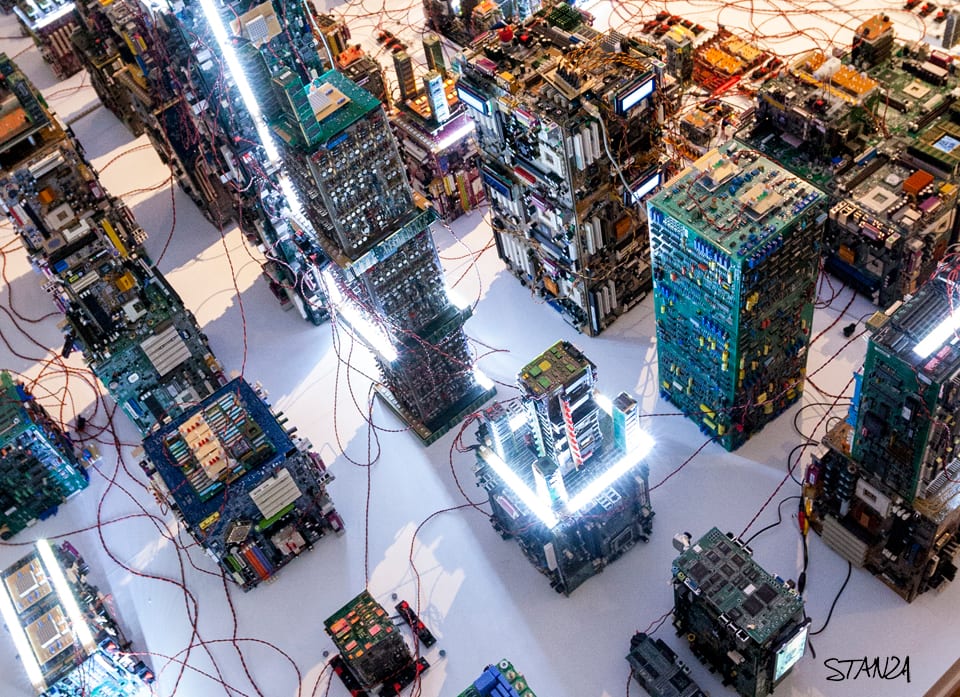“We live in a time of upheaval and uncertainty, part of an unprecedented technological and cultural revolution.” These are the words of installation and mixed-media artist Doug Aitken (b. 1968). The Californian-based innovator is best known for his immense multi-screen video and installation works, transporting viewers into kaleidoscopic worlds of sound and light. In 1999, Aitken won acclaim at the Venice Biennale with Electric Earth, a multi-room installation that screened the story of a young man feeling overwhelmed in a big city. In a series of interconnected video sequences, the piece emphasised the impact of media on contemporary life. Since then, the artist has championed an immersive, sensory practice that examines humanity’s relationship to the world around us. He holds an impressive oeuvre that has seen work installed underwater in the Pacific Ocean (Underwater Pavilions, 2016), in the snowy mountaintops of the Swiss Alps (Mirage, 2017) as well as in the sparse wilderness of Tasmania (Transformer, 2022). Now, Aitken exhibits at SCHAUWERK Sindelfingen, Germany, with Return to the Real, a retrospective that comprises ten works from the past 15 years. Spanning installation, sculpture and moving-image, it’s a show that demonstrates the dislocating yet connective power of technology and modern communication.

At the centre of the exhibition is Wilderness (2022), a 360-degree projection encompassing four screens. Created over a period of two and a half years on a beach in Los Angeles close to where Aitken lives, the artist went to the edge of the Pacific Ocean every day. Here, Aitken observes the rhythms of people gathering on the beach at sunset. Viewers watch the tide ebb and flow back and forth, offset by a series of song cycles that capture the landscape as it moves from day to night. Crowds flood in and out, sprawled out across the sand, pausing by groynes or underneath docks. It’s not a wholly comfortable watch — particularly as the work agitates and intensifies. Wildfires blaze feverishly on the horizon. Phone screens are held up to the sky, gleaming in a neon orange as they drown out the sun. Soaring planes overhead split and recur, multiplying infinitely. The artist explains, “I was fascinated by the idea of taking the chaos of the ordinary, the everyday and creating a structure within that chaos — taking this random landscape of people disconnected, drifting, and passing by and creating a connective tissue. In Wilderness, you have a friction between raw tactile scenes, like people against an old wooden pier or a parking lot filled with broken glass, someone alone, lost and gazing at the bright setting sun, juxtaposed with a digitised artificial intelligence seeping into this world and leaching into our subconscious … What is the real?”

The second installation, migration (empire) (2008) consists of three steel billboards, each equipped with five-metre-wide screens. Abandoned cities, houses and landscapes pass by in an experience that mimics a road trip. The work offers a series of vignettes showing North American migratory animals exploring roadside motel rooms. They engage with their constructed environments according to their primal instincts. A barn owl nests on a bed covered in feathers; a horse pauses by a small television set; two white peacocks stride over an orange bedspread. The piece is humorous and playful, blurring the boundaries between natural and manmade spaces. It shows a world that is restless, that has, as Welsh critic Raymond Williams wrote, “mixed its labour with the earth.” In some shots, creatures tear apart the space — a mountain lion shreds the curtains, a buffalo violently uproots the bed. In others, however, they do nothing at all, merely pausing in curiosity or fear. Aitken presents a bizarre and hypnotic display, showing the extent to which humans seek control, as they attempt to have dominion over things that do not belong to them.

Elsewhere, 3 Modern Figures (don’t forget to breathe) (2018) consists of translucent sculptures that radiate light from within. Pastel blues, ghostly whites, reds and purples emanate from figures that stand, lie and crouch on the floor. Their poses are anti-heroic and non-monumental; each person is captured in the middle of making a call. Where a phone should be clutched in their hands, there is instead negative space. This ethereal form is also explored in All doors open (2019), a translucent sculpture made of acrylic and LEDs in the shape of a woman, slouched over a table. The subject reaches out to a bright rectangle — a mobile phone — that powerfully glows, suggesting a world dictated by digital media. Aitken says, “The forms become vessels of moving light. We have become vessels of information reflecting the information that passes through us. Words, images, fragments, and stories race through our bodies and our minds. This work becomes a modern landscape of the individual.”
It’s a piece that informs a wider exhibition rooted in behaviour and fragmentation. The artist offers up a contemporary portrait of a restless, globalised world — driven by constant information, progress and technology. It speaks to other interdisciplinary installations, such as Julianknxx’s In ReMemory of Flight at The Barbican Centre, London, or John Akomfrah’s Arcadia at The Box, that use media and film as a means of documentation and observation. Overwhelmingly, Aitken tells us to pay attention to our rapidly changing environment. He asks us to look around and come into contact with the world around us, to resist being dictated by an algorithm. He notes, “When we look at art, perhaps we’re looking for a return to the real.”
Return to the Real | Until 16 June
Image Credits:
Doug Aitken, Wilderness, 2022, © Doug Aitken, Courtesy of the artist. Photography: Frank Kleinbach.
Doug Aitken, All doors open, 2019, © Doug Aitken, Courtesy the artist; Galerie Eva Presenhuber, Zürich / Wien und 303 Gallery, New York. Photography: Frank Kleinbach.
Doug Aitken, migration (empire), 2008, © Doug Aitken, Courtesy of the artist. Photography: Frank Kleinbach.
Doug Aitken, 3 Modern Figures (don’t forget to breathe), 2018; Faurschou Collection, © Doug Aitken. Photography: Frank Kleinbach.





